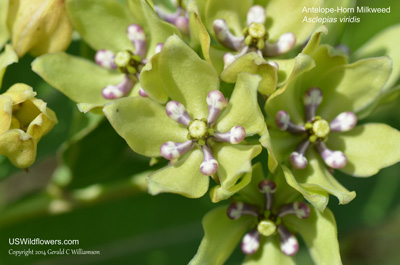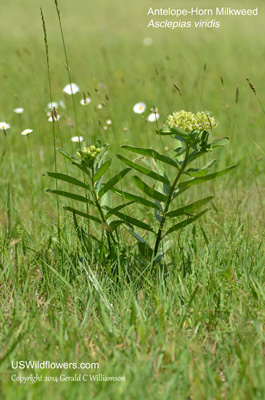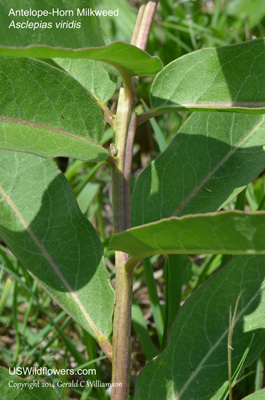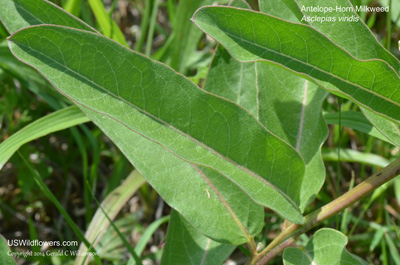Antelope-Horn Milkweed, Green Antelopehorn, Spider Milkweed, Green Milkweed - Asclepias viridis
|
Asclepias viridis - Antelope-Horn Milkweed, Green Antelopehorn, Spider Milkweed, Green Milkweed. Asclepias, Milkweed, is a large genus, with around 100 species total, and over 75 in the United States. There is at least one species in every state except for Alaska. Milkweed is important if for no other reason than the fact that the Monarch butterfly only lays its eggs on Milkweed plants, and the Monarch caterpillar only eats the leaves of the Milkweed plant.
Asclepias viridis is a fairly widespread species, being found in prairies, fields, and other dry open places in eighteen states from Ohio and West Virginia south to Florida and west to Texas and Nebraska. The common name refers to the horn-like appearance of the seedpod; unlike most Milkweeds, the flowers of Antelope-Horn Milkweed do not have horns. The white crab spider lives on the plant, giving it another of its common names.
Found in:
AL, AR, FL, GA, IL, IN, KS, KY, LA, MO, MS, NE, OH, OK, SC, TN, TX, WV
Leave comments on Asclepias viridis at this link. | 
Distribution of Asclepias viridis in the United States and Canada:

Blue=Native; Grey=Introduced
Map from USDA Plants Database:
USDA, NRCS. 2017. The PLANTS Database (http://plants.usda.gov, 08 May 2025). National Plant Data Team, Greensboro, NC 27401-4901 USA.
Search Our Database: Enter any portion of the Scientific, Common Name, or both.
Do a general Google search of the entire site:
#ad
 Follow USWildflowers on Twitter
#ad
| | Site: Chickamauga Battlefield, Catoosa County, Ga Date: 2014-May-12 | Photographer: Gerald C. Williamson
Nikon D7000
Tamron SP 90MM f/2.8 AF Macro | | The inflorescence of Asclepias viridis is a tight umbel of many flowers. | | 
| | Site: Chickamauga Battlefield, Catoosa County, Ga Date: 2014-May-12 | Photographer: Gerald C Williamson
Nikon D7000 | | The 5 spreading to erect pale green petals - most Milkweeds have reflexed petals - of Asclepias viridis provide it with the Green Milkweed common name. There are five purple hoods which are missing the horns found on most milkweeds. The flower is about an inch across. | | Click on the photo for a larger image

| | Site: Chickamauga Battlefield, Catoosa County, Ga Date: 2014-May-12 | Photographer: Gerald C Williamson
Nikon D7000 | | Open fields, prairies, and glades are common habitats for Asclepias viridis. It grows up to 30 inches tall. I’ve seen the leaves described as both "mostly alternate" and as "sub-opposite." I think that means "nearly opposite." The inflorescence is terminal, and there may be additional axillary inflorescences. | | Click on the photo for a larger image

| | Site: Chickamauga Battlefield, Catoosa County, Ga Date: 2014-May-12 | Photographer: Gerald C Williamson
Nikon D7000 | | The plant is "almost glabrous" - not quite smooth, but not quite rough enough to be called scabrous. | | Click on the photo for a larger image

| | Site: Chickamauga Battlefield, Catoosa County, Ga Date: 2014-May-12 | Photographer: Gerald C Williamson
Nikon D7000 | | The pale green leaves of Asclepias viridis are ovate-lanceolate, on short petioles, and up to 5 inches long. | | Click on the photo for a larger image

|
References used for identification and information:
|
|
| |
| #ad
|
|







